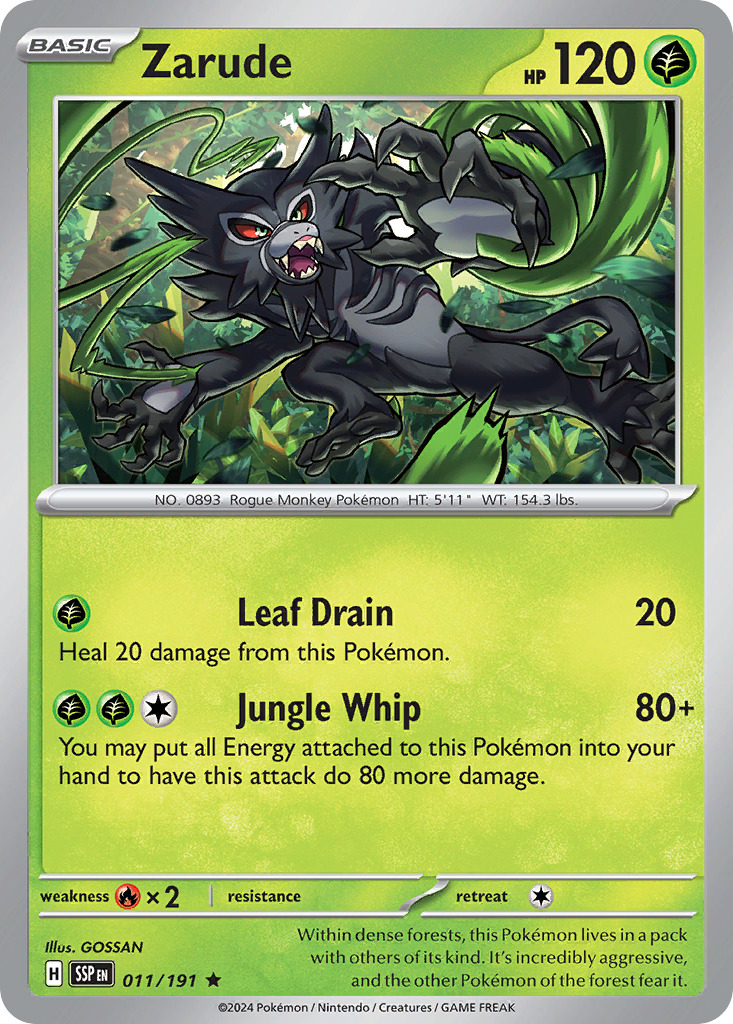zarude
Attributes
Stats
-
HP
-
Attack
-
Defense
-
Special Attack
-
Special Defense
-
Speed
Summary
Zarude is a Dark/Grass-type Pokémon introduced in Generation VIII.
Type: Dark / Grass
Abilities:
- Leaf Guard: Prevents status conditions in sunny weather.
- Hidden Ability: There is no hidden ability for Zarude.
Physical Characteristics:
- Zarude is a simian Pokémon with a primarily black fur coat and sharp, green eyes.
- It has long, vine-like appendages wrapped around its arms and neck, which can extend to assist in climbing or attacking.
- Its hands have three clawed fingers, and its feet are equipped with two toes and claws for gripping.
- Its face features a pronounced snout, red eyes, and sharp teeth, giving it a fierce appearance.
Behavior and Habitat:
- Zarude is known to inhabit dense forests, particularly those with thick canopies and plentiful vegetation.
- It is a territorial Pokémon, often living in groups. Known for its aggressive nature, it defends its territory from intruders.
- Despite its fierce demeanor, Zarude is capable of forming bonds, especially when it takes on a nurturing role.
- It uses its vine appendages to swing through trees and reach fruits high in the canopy.
In Battle:
- Zarude is a versatile physical attacker with a solid base Attack and Speed.
- Its dual typing gives it an advantage over Water, Psychic, Ghost, and Ground types, while being vulnerable to Fighting, Flying, Poison, Fire, Ice, and Fairy-type moves.
- Notable moves include Jungle Healing, its signature move, which restores HP and heals status conditions of itself and its allies.
- Other effective moves are Power Whip, Darkest Lariat, and U-turn, allowing it to hit hard and maintain momentum in battles.
Evolution:
- Zarude does not evolve from or into any other Pokémon.
Interesting Facts:
- Zarude was introduced as part of a special event, making it a mythical Pokémon.
- The Pokémon was featured prominently in the movie "Pokémon the Movie: Secrets of the Jungle," where it played a central role.
- Its signature move, Jungle Healing, is unique in that it can heal both itself and its allies, which is rare among Pokémon moves.
- Zarude's design and abilities are inspired by themes of jungle survival and the mythical concept of a guardian of the forest.
Pokémon Sprites
Evolution Chain
Moves
Level Up
- Level 1: Scratch
- Level 1: Bind
- Level 6: Leer
- Level 12: Vine Whip
- Level 18: Growth
- Level 24: Fury Swipes
- Level 30: Scary Face
- Level 36: Grass Knot
- Level 42: Bite
- Level 48: U Turn
- Level 54: Swagger
- Level 60: Energy Ball
- Level 66: Synthesis
- Level 72: Hammer Arm
- Level 78: Thrash
- Level 84: Power Whip
- Level 90: Jungle Healing
TM/HM
- Mega Punch
- Swords Dance
- Mega Kick
- Body Slam
- Take Down
- Double Edge
- Roar
- Hyper Beam
- Low Kick
- Solar Beam
- Dig
- Swift
- Rest
- Rock Slide
- Substitute
- Thief
- Snore
- Protect
- Giga Drain
- Endure
- Sleep Talk
- Encore
- Iron Tail
- Sunny Day
- Crunch
- Facade
- Focus Punch
- Taunt
- Helping Hand
- Superpower
- Revenge
- Brick Break
- Knock Off
- Hyper Voice
- Rock Tomb
- Bullet Seed
- Aerial Ace
- Bulk Up
- Mud Shot
- Magical Leaf
- Close Combat
- Payback
- Assurance
- Fling
- Dark Pulse
- Seed Bomb
- Drain Punch
- Giga Impact
- Nasty Plot
- Leaf Storm
- Low Sweep
- Round
- Acrobatics
- Snarl
- Petal Blizzard
- Grassy Terrain
- Darkest Lariat
- Solar Blade
- Throat Chop
- Brutal Swing
- Stomping Tantrum
- Tera Blast
- Trailblaze
Breeding
Tutor
Other
Flavor Text Entries
- Sword: Within dense forests, this Pokémon lives in a pack with others of its kind. It’s incredibly aggressive, and the other Pokémon of the forest fear it.
- Shield: Once the vines on Zarude’s body tear off, they become nutrients in the soil. This helps the plants of the forest grow.
Pokedex
Cards

Created by Unknown for the Unknown Set set.

Created by Shiburingaru for the Unknown Set set.

Created by Planeta Igarashi for the Unknown Set set.

Created by Planeta Igarashi for the Unknown Set set.

Created by Kouki Saitou for the Unknown Set set.

Created by Shin Nagasawa for the Unknown Set set.

Created by Anesaki Dynamic for the Unknown Set set.

Created by 5ban Graphics for the Unknown Set set.